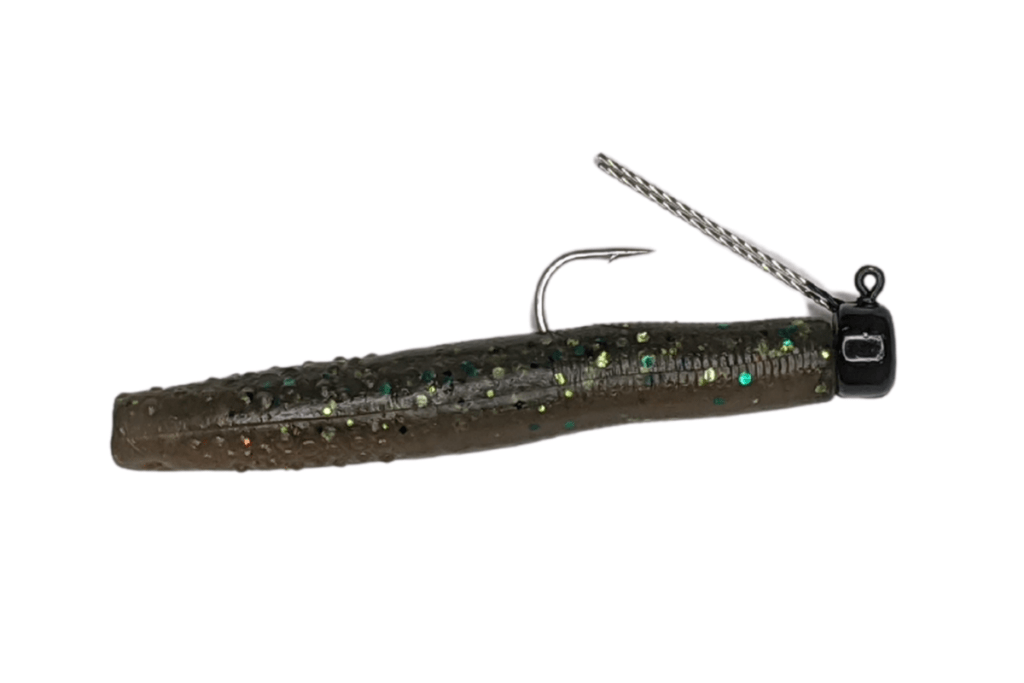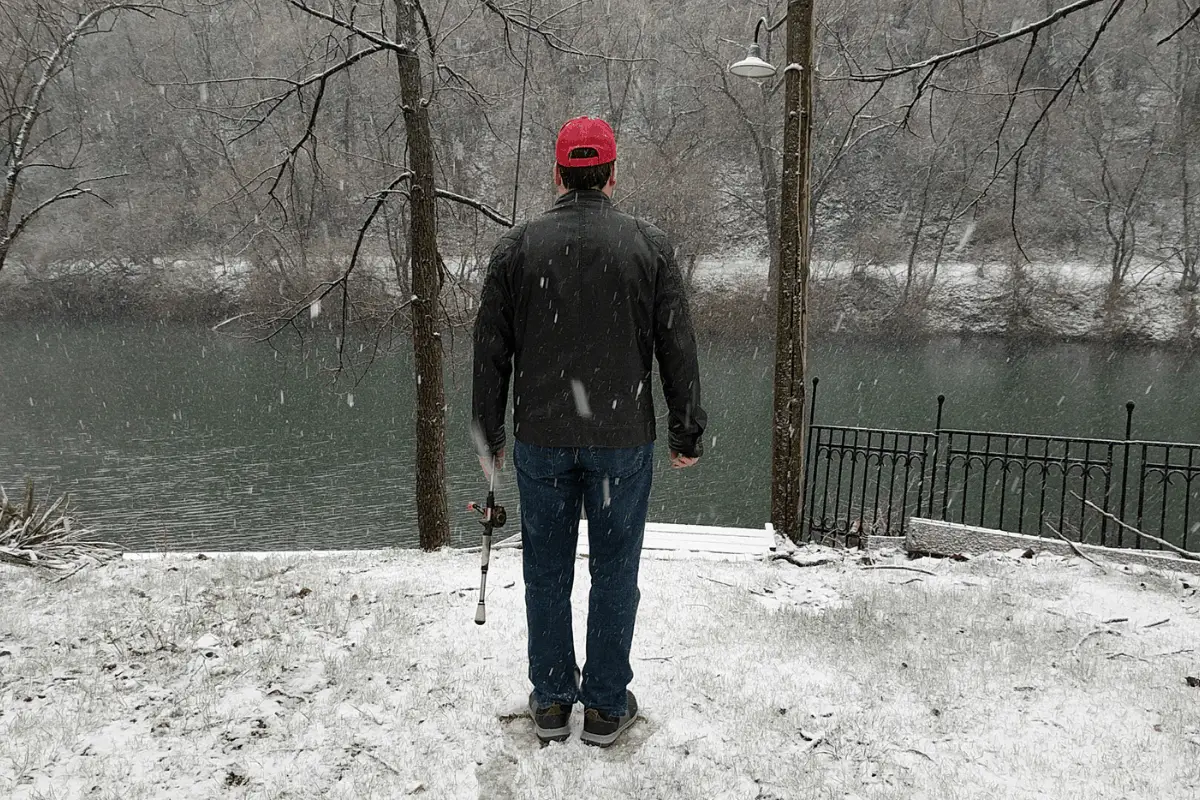Winter bass fishing can be downright frustrating. I see why. All summer long I can stand on my own dock and see a plethora of activity. Then winter comes, and poof, everything disappears. Once we locate them, the draggin’ method is about as simple and effective as fishing gets. For questions on how to locate winter bass, read this article.
Draggin’ for winter bass is highly effective. I like to use a Ned rig or flipping jig. Cast them out and let the baits sink to the bottom. Let them drag as you move. Pop the lure every so often to clear debris, and keep fishing.
Let’s break down the specifics of the draggin’ method and why it works so well.
The Lures for Dragging Winter Bass
As mentioned above, my two favorite lures for this method are the Ned rig and just a simple flipping jig. Depending on the depth you are targeting, you may need to go fairly heavy. As a general starting point, I like to focus on ¼ oz for the Ned rig and a ½ oz for a traditional jig, but do not be afraid to experiment with different weights to efficiently get to the bottom, but not so heavy the lures get lodged and stuck all the time. You want the baits to just tick, or bounce along the lake or river bed. If you feel the lure getting hung and then popping free constantly, that means the weight is too heavy.
When using a Ned rig, I choose some sort of color that resembles crawdads. I do the same with a standard flipping jig. For the jig trailer, I prefer something that also looks like a craw so I’ll tip the jig with either a twin-tail grub or a craw trailer. Once again, I’ll choose colors that mimic crawdads in the area.
It is OK to experiment with color if you are not getting bit. Bass in cold water will take a good long look at these lures before committing to them. The more natural the lure is in the winter, the more likely you are to get a strike. Slight differences in color can be just what it takes to convince that bucketmouth to commit to an easy meal.

The Equipment Used for Dragging
For the Ned rig, I will use a medium heavy spinning rod with line in the 6 – 8lb range. Either mono or fluoro work well. If I am going to drag a flipping jig, my rod of choice is medium heavy with a fast tip. The length of both rods will be around the 7ft mark.
For my jig rod, I prefer to use a slow gear ratio baitcaster, something in the 5.2:1 range. Normally, I have high speed reels on my jig rods, but with this method, the slower the better.
A quality rod is also important. You will feel many more bites and be able to decipher what the actual bottom composition is when using a sensitive rod. Remember, a quality rod means getting the lightest material possible, yet still maintaining strength. A $20 rod is not going to work as well as one that breaks the $100 mark.
The Presentation
Method 1
You can let the wind push you along. Make a long cast and let the lure sink to the bottom. Do not reel it in. Just let the wind keep you going. Make sure that you feel the bottom the entire time. If you cannot maintain bottom contact, either add a heavier weight, or you will need to try an alternate method of lure movement, because the wind may be too strong. Pop the rod every so often to clear debris from the lure and let it settle back to the bottom. Remember, feeling the bottom is key to success.
Method 2
You can impart your own action on the lure. Use a slow side sweep of the rod, reel up the slack, and repeat. The danger in this second style is that we tend to fish the lure way too fast, but this is why I mentioned using a slower gear ratio reel. Our summertime habits come back and we may fish like this for hours and not even notice that we are wasting our time.
Method 3
The last method is my favorite. Set your trolling motor anywhere from 10-20%. Cast the lure out, let it sink, and then just let the trolling motor do all the work. This method is so effective because it eliminates all possibility of us moving the bait too quickly. Using this method of delivery is also the easiest for the angler to focus on what is happening on the end of the line. Day-in-and-day-out, this third method is what I prefer to use because it works so well.
The Bite and Hookset
It is not a surprise that during the winter, bass are sluggish and the bite is almost imperceptible. Most of the time, you will just notice some slight tension, or additional weight on the line.
If you are using the draggin’ method properly, there will be no slack in your line at all. This means the hookset is immediate, so if there is something that feels strange or spongey, set the hook.
This time of year you want to avoid the hard, lip ripping hooksets that are so fun in the spring and summer. Just use a side sweep method and apply steady pressure to the lure. Reel down tight and keep tension. If your hooks are sharp, you will catch the bass because their was no slack line in the presentation and all of your energy was transferred directly to the hook itself.
Final Thoughts
Once you fall in love with the draggin’ method, you will quickly apply it to other situations throughout the year. Co-anglers in bass tournaments, who have been relegated to the back deck of the boat, have used this method very effectively for decades.
It is not the most exciting method to use, or the fastest, but it is one of the most effective. Why? Because the lure is in the zone 99% of the time. This method eliminates a lot of the casting, sinking, and winding that other retrieves require.
If you notice that your lure is constantly getting covered in debris, use your rod to give it a good pop every so often. This will do two things for you: 1) it will clear the junk from your lure, and 2) it might just elicit a reaction strike from a bass that was following it along.
Good luck this winter with the draggin’ presentation. I promise you, it will work. Keep good contact with the bottom and pay attention to the end of that line.

